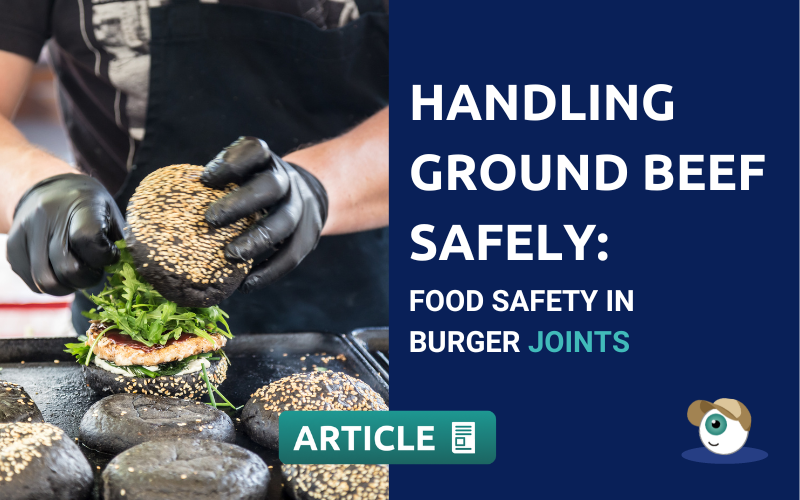Handling Ground Beef Safely: Food Safety in Burger Joints

Burger joints have become emblematic of American culinary culture everywhere in the world.
The fast-food nature of this concept makes burger bars an attractive option for people seeking a quick and satisfying meal on the go.
However, beyond the sizzle of grills and the aroma of freshly cooked patties lies a critical consideration: food safety.
The improper handling of ground beef, a staple ingredient in burgers, can lead to dire consequences for customers’ health.
In today’s post, we delve into the nuances of ensuring food safety in burger joints, shedding light on best practices for handling ground beef to guarantee a safe and enjoyable dining experience.
The Importance of Food Safety in Burger Joints
Within the restaurant industry, food safety is not just a regulatory obligation; it’s an essential component of responsible and ethical food service.
Burger joints, in particular, must be vigilant in their handling of ground beef, a key ingredient that, if mishandled, can lead to foodborne illness outbreaks.
The repercussions of such incidents extend beyond customer health, encompassing legal liabilities and potential reputational damage for the establishment.
The Vulnerability of Ground Beef to Food Safety Risks
Ground beef is particularly susceptible to contamination and subsequent health risks. This vulnerability stems from both the nature of ground beef and the processes involved in its production. Let’s try to understand why ground beef stands out as a potential source of foodborne illnesses.
Increased Surface Area: Ground beef, as its name suggests, is finely minced or ground into smaller particles compared to whole cuts of meat. This increased surface area provides a larger canvas for harmful bacteria to proliferate. Contaminants that might be present on the surface of the meat can spread more easily throughout the ground product during processing and cooking.
Mixing of Batches: Ground beef is often a combination of meat from multiple sources. This mixing process, while aimed at achieving desired fat ratios and flavour profiles, can also introduce contaminants from various batches. If one batch is contaminated, it can potentially affect the safety of the entire batch of ground beef.

Inadequate Cooking: Due to its finer texture, ground beef can pose challenges when it comes to ensuring thorough and uniform cooking. If not cooked to the recommended internal temperature, harmful bacteria that might be present in the meat can survive and cause illness.
Cross-Contamination: The very process of handling and preparing ground beef can create opportunities for cross-contamination. The utensils, cutting boards, and surfaces used to handle raw ground beef can transfer harmful pathogens to other foods if not properly cleaned and sanitised.
Temperature Sensitivity: Ground beef is more susceptible to temperature changes, particularly during storage and transportation. If not maintained at proper temperatures, harmful bacteria can multiply rapidly, increasing the risk of contamination.
Bacterial Attachment: The grinding process can potentially spread bacteria present on the surface of the meat throughout the product. This is why it’s crucial to ensure that the meat is sourced from reputable suppliers that follow stringent food safety practices.
Handling Complexity: The numerous steps involved in the production and distribution of ground beef, from slaughtering to grinding and packaging, increase the opportunities for contamination to occur. Each stage must be executed with precision to minimise risks.
Safe Handling of Ground Beef: Best Practices
How can your kitchen teams prevent the risks outlined above?
Receiving and Storage: Receiving ground beef from trusted suppliers is paramount.
The journey to ensuring food safety starts with sourcing quality ingredients. Once received, ground beef should be stored at the appropriate temperature to inhibit bacterial growth. Employing separate containers for different types of meat prevents cross-contamination and upholds the integrity of each batch.
Thawing Practices: The process of thawing ground beef demands attention.
Leaving it to thaw at room temperature can create a breeding ground for harmful bacteria. Safe methods include thawing in the refrigerator or using the microwave’s defrost setting. These methods maintain the quality of the meat while minimising the risk of bacterial proliferation.
Preparation: A clean and sanitised kitchen environment is non-negotiable during burger preparation.
Using cutting boards and utensils reserved exclusively for raw ground beef significantly reduces the likelihood of cross-contamination. Such measures ensure that pathogens do not infiltrate cooked foods.
Cooking Temperatures: The critical aspect of burger safety lies in its cooking temperatures. Ground beef should be cooked to an internal temperature of 160°F (71°C) to eliminate harmful bacteria. A calibrated meat thermometer guarantees accuracy, ensuring that burgers are not only delicious but safe for consumption.
Cross-Contamination Prevention: Hand hygiene among kitchen staff is pivotal. Gloves should be used judiciously, and frequent handwashing is imperative to prevent cross-contamination. Proper glove usage, combined with regular hand hygiene, minimizes the transfer of contaminants from one surface to another.
Serving and Holding: Serving cooked ground beef promptly is essential. Delayed service can lead to bacterial growth, compromising the safety of the dish. To maintain the integrity of cooked patties, they should be held at a safe temperature, typically above 140°F (60°C), until served.

Employee Training and Education: Central to effective ground beef handling is well-informed staff.
Comprehensive training ensures that every team member understands and adheres to food safety protocols. Regular education updates keep staff current on the latest best practices, fostering a culture of vigilance and accountability.
Regulatory Compliance and Legal Consequences: Burger joints are subject to food safety regulations to safeguard public health.
Failure to comply not only jeopardises customer well-being but also invites legal ramifications and financial liabilities. Foodborne illness incidents are not only costly but can also tarnish the reputation of an establishment.
How can Andy Help with the proper handling and preparation of ground beef in burger joints?
With its advanced features and user-friendly interface, the digital food safety assistant Andy serves as an indispensable tool to ensure that every step of ground beef handling aligns with the highest safety standards.
- Customised Checklists for Ground Beef Handling:
Andy comes equipped with meticulously designed checklists tailored specifically for the handling and preparation of ground beef.
These checklists encompass every critical stage – from receiving to serving – ensuring that no essential task is overlooked. Customisation options allow burger joints to align the checklists with their unique processes and regulatory requirements.
- Real-time Temperature Monitoring:
Ground beef’s vulnerability to temperature fluctuations demands constant vigilance.
Andy offers real-time temperature monitoring, alerting staff to any deviations from safe ranges. Whether it’s during storage, transportation, or cooking, this feature safeguards against bacterial growth and the potential for contamination.
- Cross-Contamination Prevention:
With ground beef, cross-contamination is a prime concern.
Andy provides step-by-step guidelines to prevent cross-contact with other ingredients and surfaces. By delineating separate utensils, cutting boards, and workspaces, Andy ensures that harmful pathogens are kept at bay.
- Thorough Training and Education:
Ground beef safety hinges on knowledgeable staff.
Andy facilitates comprehensive training modules that cover every facet of ground beef handling. From safe thawing practices to proper cooking temperatures, Andy ensures that every team member is equipped with the expertise needed to maintain food safety standards.
- Real-time Reporting and Insights:
Andy’s reporting capabilities offer real-time insights into ground beef handling practices.
Managers gain immediate access to data that highlights compliance, identifies trends, and pinpoints areas for improvement. This data-driven approach enables timely adjustments and promotes a culture of continuous enhancement.
- Documentation and Traceability:
Andy’s digital platform simplifies documentation and traceability.
Records of ground beef sourcing, storage temperatures, preparation processes, and serving times are easily accessible. This streamlined documentation not only facilitates regulatory compliance but also aids in addressing any issues that may arise.
- Notifications and Alerts:
Andy’s alert system ensures that critical tasks are not missed.
From reminding staff to thaw ground beef using safe methods to notifying about upcoming audits, this feature keeps teams proactive and ensures that food safety measures are consistently upheld.
- Regulatory Compliance and Assurance:
By aligning with industry regulations and guidelines, Andy offers burger joints a reliable tool to maintain compliance.
Its robust features serve as a safety net, reducing the risk of violations and protecting establishments from potential legal consequences.
Try Andy App now and discover the many benefits of having this helpful Food Safety digital assistant helping your
restaurants/food service business’ teams!
👉🏽START 100% FREE HERE!👈🏽

